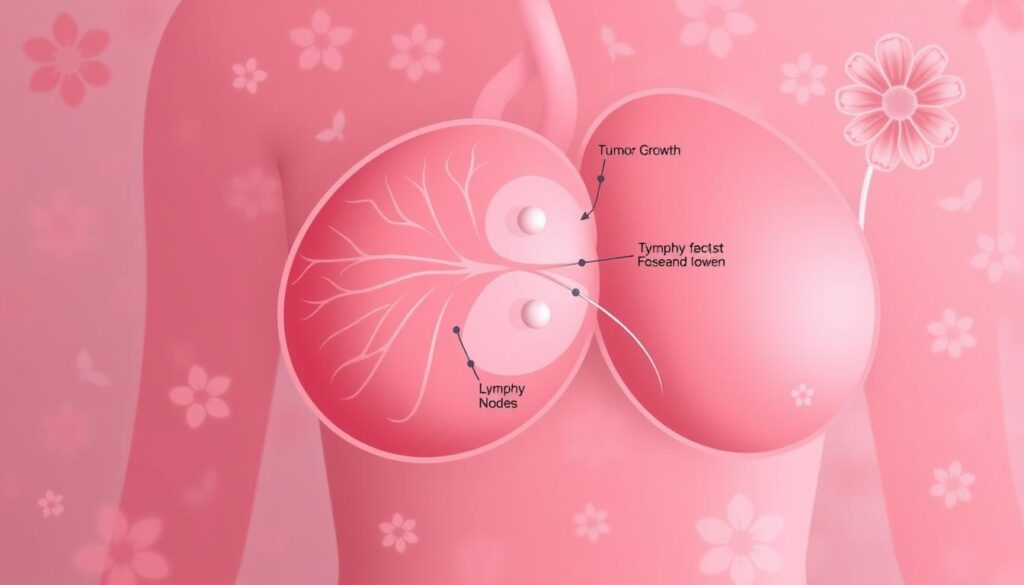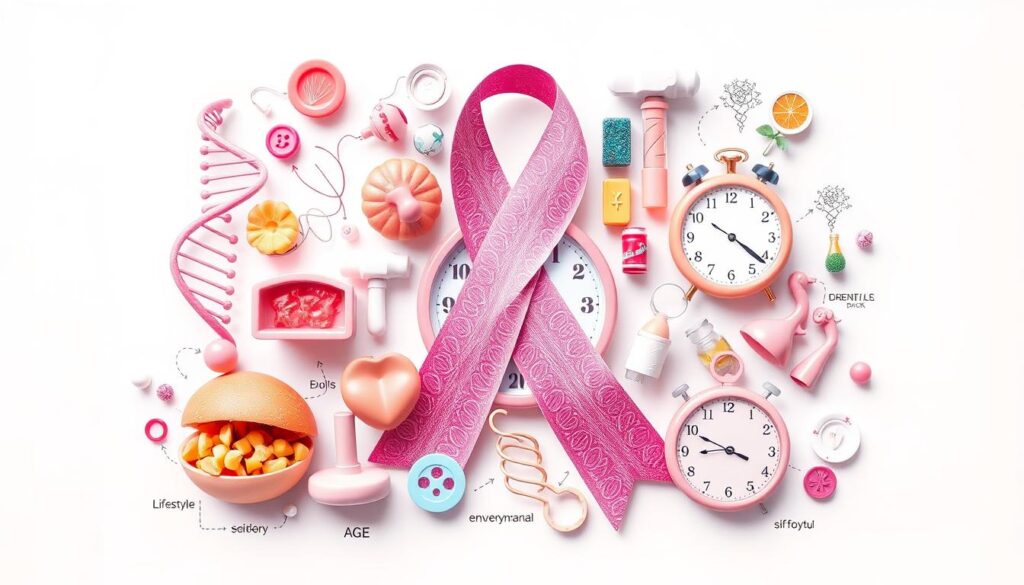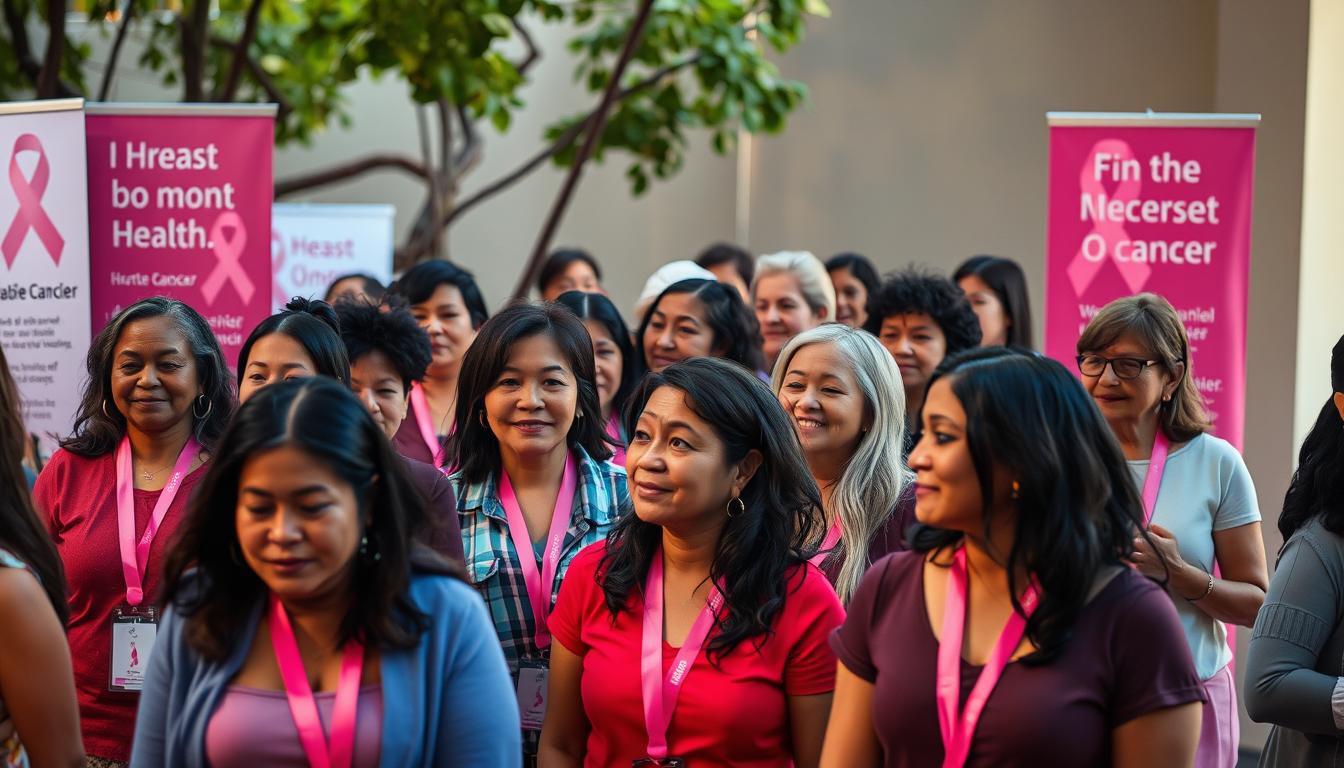Today, we’re talking about something very important: breast cancer awareness. It’s close to my heart and affects many women, their families, and communities. It’s not just about the disease; it’s about empowering women through knowledge, prevention, and early detection.
Did you know that nearly 1 in 8 women in the United States will be diagnosed with breast cancer at some point in their lifetime? That’s over 250,000 women every year1. Early detection is key to successful treatment, and awareness helps spread this important info2. Keep reading to learn how knowing about breast cancer can improve your health and well-being.
Key Takeaways
- Breast cancer is one of the most common cancers affecting women worldwide2.
- Nearly 1 in 8 women in the US will be diagnosed with breast cancer during their lifetime1.
- The importance of early detection and regular screenings cannot be overstated.
- Breast Cancer Awareness Month in October raises vital awareness and provides support.
- Small lifestyle changes can reduce the risk of breast cancer.
We have a lot to cover, including the importance of mammograms, self-exams, and the big impact of Breast Cancer Awareness Month. Let’s dive in and learn the knowledge that could make a real difference.
Introduction to Breast Cancer Awareness

Knowing what is breast cancer is key to raising awareness. It’s a common cancer that affects women worldwide. This makes it important to spread the word and support health efforts3.
The role of breast cancer awareness is huge. In 1985, the American Cancer Society and AstraZeneca started National Breast Cancer Awareness Month. This month, known as Pinktober, has helped a lot in finding and treating breast cancer early3.
Thanks to awareness campaigns, more cases are caught early. This means better treatment chances for women3. Early detection is key to beating the cancer before it spreads3.
Understanding what is breast cancer is linked to fighting it. In the USA, it’s a top cause of death for women4. In 2021, there were 281,550 new cases of invasive breast cancer in women4.
Also, 49,290 new cases of ductal carcinoma in situ (DCIS) were reported4. Sadly, about 43,600 women will die from breast cancer this year4. But, the death rate has dropped by 40% in developed countries from the 1980s to 20204.
In October, the pink ribbon symbol is everywhere. It’s part of events like foot races and conferences to raise money and awareness3. These efforts are vital for screening and research, but we also need to avoid over-testing and treatment3.
By learning about what is breast cancer and its numbers, we can help. If countries can lower deaths by 2.5% each year, they can save 2.5 million lives by 20404.
Knowledge is Power: Understanding Breast Cancer

Knowing the risk factors of breast cancer helps you take charge of your health. Spotting early signs like unusual lumps and ongoing pain is key. Early detection boosts treatment success, with most early cancers being curable without major surgery56.
Following screening guidelines, like regular mammograms, is important. It helps keep an eye on breast health and catches problems early.
- Learning about risk factors, symptoms, and screening can lead to early detection and better outcomes6.
- 1 in 8 women will get a breast cancer diagnosis in their lifetime5.
- The 5-year survival rate for breast cancer caught early is 99%7.
Screenings are vital. Early-stage breast cancer survival rates can be over 90%, showing how timely detection saves lives5. Lifestyle choices like diet, exercise, and avoiding tobacco also affect breast cancer risk6.
Regular self-exams and mammograms are your breast health allies. Being informed about breast cancer gives you confidence and a proactive stance on your health. Over 10,000 women are committing to breast health screenings and mammograms next year7. Awareness and education create a supportive environment for those dealing with breast cancer, proving that knowledge is truly power.
The Role of Early Detection
Early detection of breast cancer is key. It greatly improves a woman’s survival chances and treatment options. Research proves that catching cancer early leads to more effective treatments and better outcomes8. The phrase “How Early Detection Saves Lives” is more than a slogan; it’s a truth.
Women over 40 should get annual mammograms. These screenings can find breast cancer in its earliest stages, when it’s most treatable8.
In low-income and middle-income countries, many women are diagnosed too late. This makes treatment harder and less effective9. Women often notice symptoms like lumps or thickening only when the cancer is advanced9.
Regular breast self-exams and medical check-ups are vital for early detection and better health8.
Healthcare experts recommend using mammograms, breast MRI, and ultrasound for high-risk women8. It’s important for doctors to spot early signs of breast cancer and refer women quickly9. Free guides that explain how to recognize symptoms are great resources for women everywhere9.
Looking at the numbers, early detection’s importance is clear. A 90% chance of beating breast cancer with early diagnosis shows the power of regular screenings10. Black women in the U.S. face higher mortality rates due to late diagnoses and delayed treatments10. We must fight for equal access to screenings and prompt treatment to save lives.
Encouraging Mammograms and Self-Exams
As women, it’s vital to know the benefits of regular mammograms for our health. Mammograms can find breast cancer up to three years before it’s felt. This early catch means more treatment options and less invasive procedures11. It gives us peace of mind and a baseline for future checks11.
Most health insurance plans cover mammograms for women starting at 40 with no cost. This makes it easier to get these important health check-ups12. The US Preventive Services Task Force says women aged 40 to 74 should get a mammogram every two years12. The CDC also offers free or low-cost mammograms for those who qualify12.
While mammograms are key, it’s also important to know about other factors. Screening tests can sometimes lead to false positives, causing more tests and worry12. Overdiagnosis can also mean unnecessary treatments12. Yet, studies show regular mammograms greatly lower the risk of dying from breast cancer11.
Even though clinical and self-exams may not lower breast cancer death risk, they’re valuable tools12. Doing a self-exam is simple:
- Start by looking at your breasts in the mirror, noting any changes in size, shape, or color.
- Raise your arms and look for the same changes.
- Check for any fluid coming out of one or both nipples.
- Feel your breasts while lying down, using a firm, smooth touch with the first few finger pads, keeping them flat and together.
- Feel your breasts while standing or sitting, best performed when your skin is wet and slippery.
The benefits of regular mammograms and self-exams are a complete approach to breast health. Mammograms are very accurate, while self-exams help you know your breasts. This makes spotting changes easier.
From my own experience, adding these health measures to your routine is empowering. Encouraging mammograms and self-exams helps us detect breast cancer early. This way, we can take control of our health effectively.
Supporting Those Affected by Breast Cancer
Supporting those with breast cancer means listening and showing empathy. Every year, about 240,000 women in the U.S. are diagnosed with breast cancer13. It’s key to help them emotionally for their recovery.
A great way to help is through community engagement. Joining events and fundraisers can make a big difference. In the U.S., 270,000 women get breast cancer each year, leading to 42,000 deaths14. This shows how important it is to work together.
Organizations like the CDC’s National Breast and Cervical Cancer Early Detection Program help a lot. They offer free or low-cost mammograms to those who can’t afford it14. Getting involved in these efforts can unite us and strengthen support networks.
By listening and getting involved, you can really help those fighting breast cancer. Together, we can create a more caring and supportive space for everyone.
The Impact on Families and Communities
Breast cancer affects not just the person diagnosed but also their families and communities. It’s a tough emotional journey that goes beyond the person with the disease. It changes how families and communities interact.
When someone is diagnosed, families face uncertainty, fear, and anxiety. Having a strong support system is key. Events like awareness campaigns and educational programs help a lot. They offer emotional and practical support.
Studies show that social support can improve a patient’s quality of life. It can reduce anxiety, stress, and depression. It also helps with fatigue and pain15.
Communities also feel the effects of breast cancer. Awareness activities teach the importance of early detection. They share vital information and resources. This can be a game-changer.
For example, women who get mammograms have a lower risk of dying from breast cancer. Regular mammograms can cut the risk by up to 30% for women over 5016.
Here’s a quick look at how breast cancer affects families and communities:
| Impact Area | Effect |
|---|---|
| Emotional Toll on Families | Anxiety, fear, uncertainty, requiring strong support systems |
| Community Support | Increased awareness, educational efforts, and reduced stigma |
| Early Detection Benefits | Lower mortality rates; screening mammograms decrease death risk by 30% in older women |
| Quality of Life Improvement | Reduction in stress, anxiety, and emotional distress via social support |
The Importance of Breast Cancer Awareness Month
Breast Cancer Awareness Month is key in starting global talks about breast cancer. It’s filled with activities to raise awareness and funds. This month highlights the need for early detection and better treatments. It began in 1985, aiming to support those with breast cancer and educate the public.
The pink ribbon is a big part of this campaign. Introduced by Susan G. Komen in 1990, it symbolizes the fight against breast cancer. It sparks conversations and motivates people to join awareness events and support research.
This month also focuses on the importance of regular screenings. Mammograms are the best tool for early detection, greatly improving survival chances1718.
The COVID-19 pandemic has made many skip their screenings. This has slowed down treatment and research17. Yet, awareness campaigns keep pushing the message that early detection is key to saving lives.
Statistics show that one in eight women in the U.S. will get breast cancer, with over 40,000 deaths each year18. These numbers show how vital awareness efforts like Breast Cancer Awareness Month are.
There are also big disparities in treatment outcomes. Black women in the U.S. are 40% more likely to die from breast cancer than white women17. This highlights the need for equal access to knowledge and screenings for all women.
Organizations like Susan G. Komen have made a huge difference. They’ve helped lower mortality rates through early detection and better treatments17. Their hard work brings hope and strength to the breast cancer community.
Every action during Breast Cancer Awareness Month counts. Whether it’s joining events, wearing a pink ribbon, or learning more, it all helps. Together, we can honor survivors, remember those we’ve lost, and work towards a future without breast cancer.
Fostering Emotional and Mental Well-being
Taking care of mental health in cancer care is key. It’s not just about fighting the disease. It’s also about giving emotional support for cancer patients. Studies reveal that up to 25% of breast cancer patients feel depressed, and about 45% are anxious about their diagnosis and treatment19.
A study with ninety-five Portuguese women with breast cancer found that trouble managing emotions affects their well-being20. They face challenges like not having good ways to handle emotions and not being clear about their feelings20. Using strategies that fit their changing situation can help them feel better20.
Cognitive-behavioral therapy (CBT) helps reduce anxiety and improve emotional control, working for about 50-75% of breast cancer patients19. Support groups also help, with 80% of members feeling less alone and more connected19. Individual therapy helps with body image, relationships, and grief, improving self-acceptance and emotional well-being in 60-70% of cases19.
Breast cancer treatments can cause long-term issues like fatigue and chronic pain, affecting 30-40% of survivors19. This shows the need for ongoing therapy to manage these problems. After treatment, up to 30% of survivors may have PTSD or other mental health issues, showing the importance of emotional support for cancer patients19. Adding therapy to care plans can boost emotional resilience and quality of life, improving well-being and coping by up to 80%19.
Here’s a comparison of various support strategies and their reported benefits:
| Support Strategy | Reported Benefit |
|---|---|
| Cognitive-Behavioral Therapy (CBT) | 50-75% effectiveness in reducing anxiety and improving emotional regulation19 |
| Support Groups | 80% reported decreased isolation and increased emotional connection19 |
| Individual Therapy | 60-70% improved self-acceptance and emotional well-being19 |
Understanding mental health in cancer care and providing emotional support can greatly improve the lives of breast cancer patients.
Promoting Healthy Lifestyles to Reduce Risk
A healthy lifestyle is key to lowering breast cancer risk. A balanced diet and regular exercise are essential. Eating more plant-based foods, healthy fats, and lean proteins helps. Avoiding processed and red meats is also important, more so after menopause21.
Regular physical activity is vital. Aim for at least 150 minutes of moderate exercise or 75 minutes of vigorous exercise weekly. Keeping a healthy weight is also critical, as obesity increases risk22. Taller women and those with high body weight post-menopause face higher risks22.
Drinking alcohol, even a little, raises breast cancer risk21. Cutting down or quitting alcohol is wise. Smoking is another risk factor. Quitting and avoiding secondhand smoke are key steps21.
Breastfeeding for a long time offers protection against breast cancer21. While organic food may not directly lower risk, eating a variety of fresh fruits and vegetables is good23.
- Alcohol reduction
- Increasing exercise
- Healthy diet
Be careful with hormone therapies and birth control. Some studies show a slight increase in breast cancer risk21. Always talk to your doctor about the risks and benefits.
Regular screening and early detection are vital. Mammograms and self-exams help improve survival rates when cancer is found23. These healthy habits not only lower risk but also boost overall health.
Research and Funding Contributions
Funding for breast cancer research is key. Money raised during Breast Cancer Awareness Month helps fund new research, treatments, and tools. This leads to big progress every year24. For example, the discovery of breast cancer stem cells was made possible by the Breast Cancer Research Foundation (BCRF)25. These stem cells help us understand cancer better, which is important for finding new treatments.
We’ve learned that breast cancer is not just one disease. It has different types that grow and react to treatments in different ways. This knowledge helps doctors create treatments that fit each person’s needs25. Also, global efforts during Breast Cancer Awareness Month help us share knowledge and speed up our fight against cancer worldwide24.
New diagnostic tools have been developed thanks to funded research. These tools help doctors find and treat early-stage breast cancer more accurately25. Research into the body’s immune system and how it fights cancer is also promising. By supporting research worldwide, we’re making breast cancer diagnosis, prevention, and treatment better for everyone25. Plus, studies show that emotional and mental health are just as important as physical health during recovery. Your donations help make these improvements possible, leading to new treatments and discoveries.
Source Links
- The Importance of Breast Cancer Awareness Month
- Why Learning About Breast Cancer Awareness is Crucial – Memorial Hospital of Carbon County
- Breast Cancer Awareness
- Breast cancer awareness month and its Importance
- Knowledge Is Power: Breast Cancer Detection
- Why Learning About Breast Cancer Awareness is Crucial – Macon Community Hospital
- BCAM Resources – National Breast Cancer Foundation
- Breast Cancer Awareness Month: The Importance of Early Detection – Ally Medical
- Breast cancer early detection: a phased approach to implementation
- Early Detection is Important in Breast Cancer Care
- Breast Cancer Awareness: The Importance of Mammograms and 5 Key Benefits
- Screening for Breast Cancer
- Breast Cancer Awareness Month: The importance of early detection and support
- Breast Cancer Awareness
- Supporting Breast Cancer Patients | Heart to Heart Hospice
- Taking Charge of Your Health: Breast Cancer Awareness and the Power of Early Detection
- Breast Cancer Awareness Month
- October 2022 – Breast Cancer Awareness Month
- The Importance of Mental Health During Breast Cancer Treatment – Alium Health
- Difficulties in emotion regulation and well-being in breast cancer
- Breast cancer: How to reduce your risk
- Lifestyle changes for prevention of breast cancer
- Healthy Lifestyle
- The Importance of Breast Cancer Awareness Month
- Our Progress | Breast Cancer Research Foundation












Comments are closed